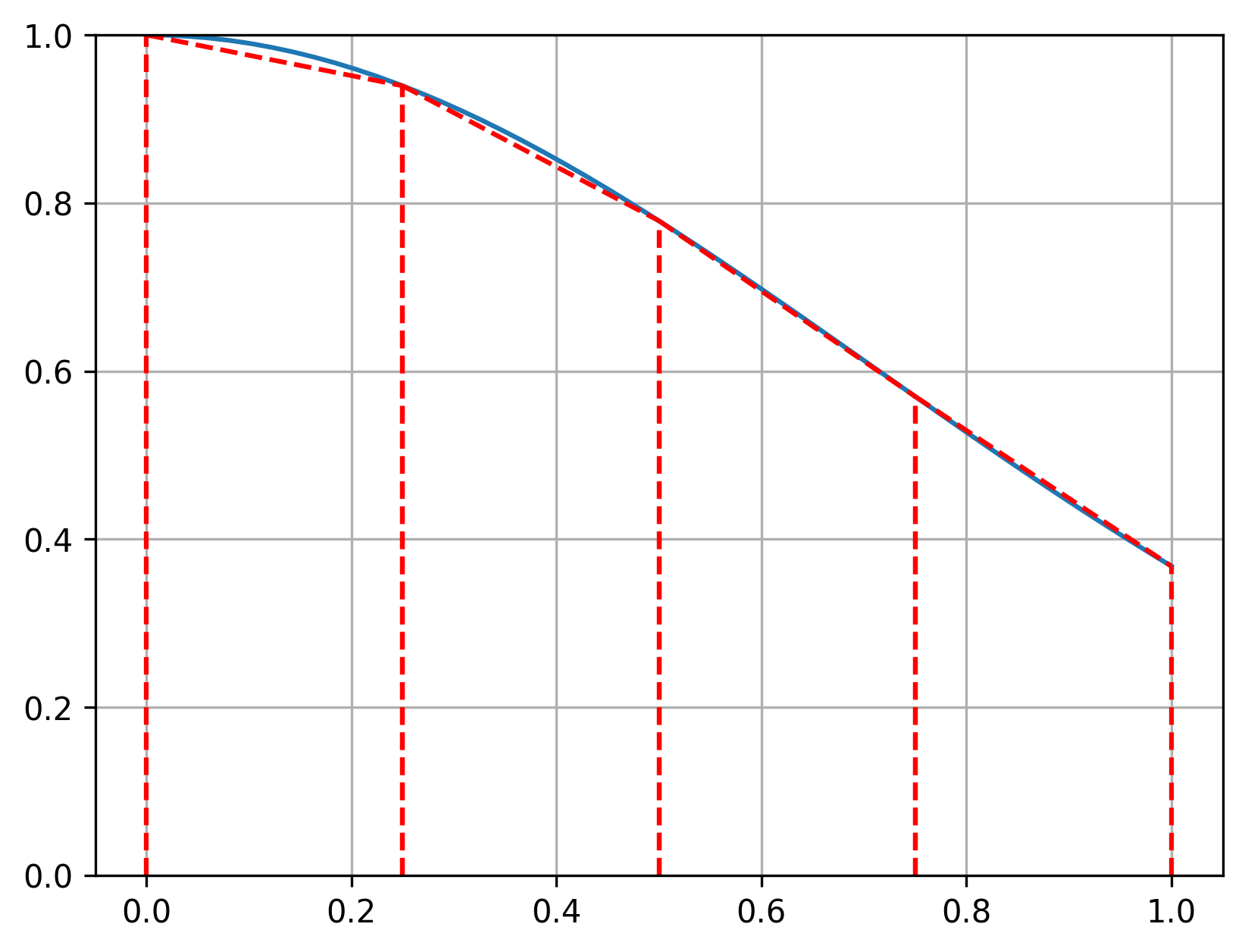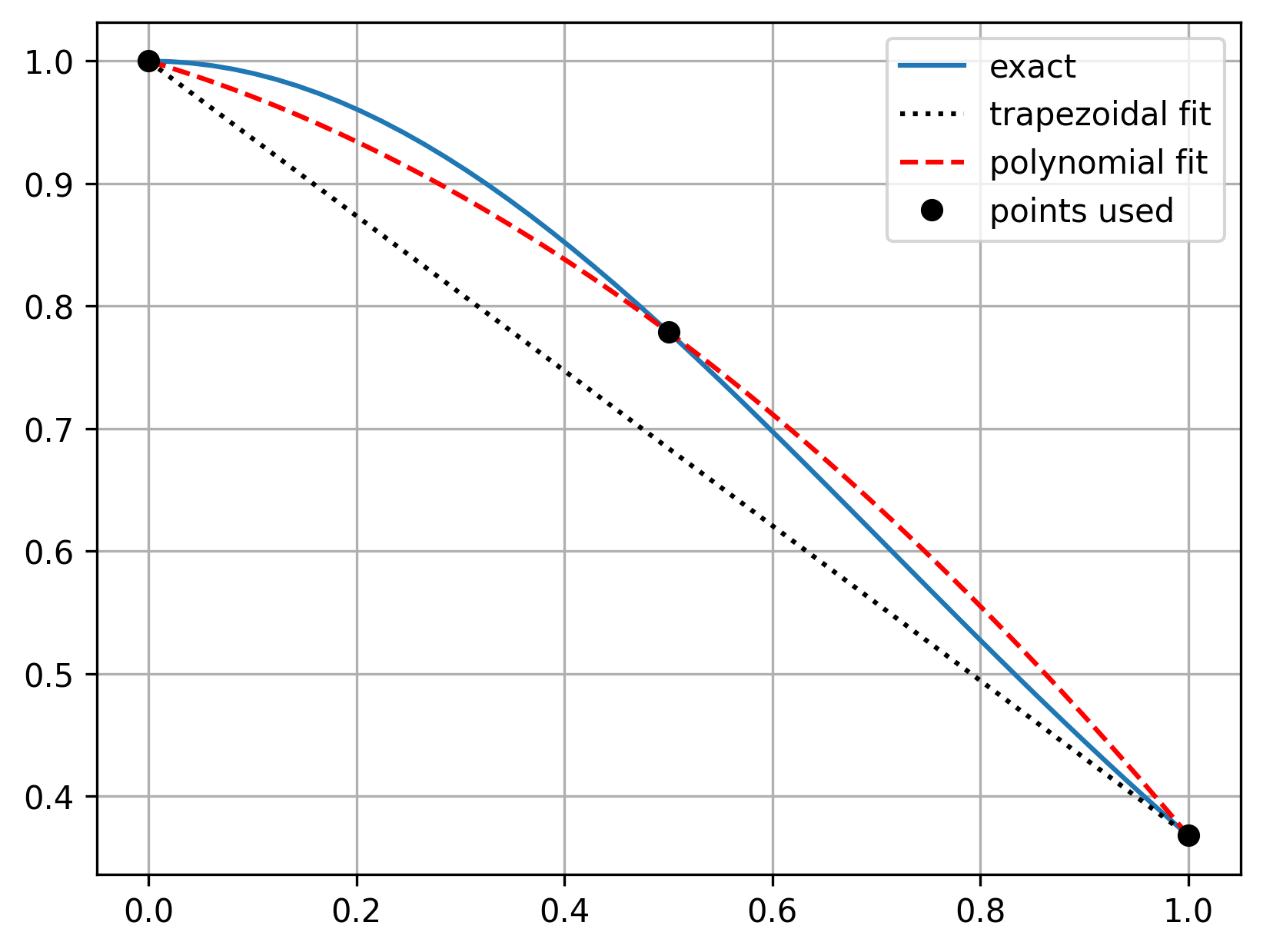2.1. Numerical integrals#
What about when we cannot integrate a function analytically? In other words, when there is no (obvious) closed-form solution. In these cases, we can use numerical methods to solve the problem.
Let’s use this problem:
(You may recognize this as leading to the error function, \(\text{erf}\): \(\frac{1}{2} \sqrt{\pi} \text{erf}(x) + C\), so the exact solution to the integral over the range \([0,1]\) is 0.7468.)
# import libraries for numerical functions and plotting
import numpy as np
import matplotlib.pyplot as plt
# these lines are only for helping improve the display
import matplotlib_inline.backend_inline
matplotlib_inline.backend_inline.set_matplotlib_formats('pdf', 'png')
plt.rcParams['figure.dpi']= 300
plt.rcParams['savefig.dpi'] = 300
We’ll create a function representing the derivative to be integrated, for convencience, and plot it to see its shape:
def func(x):
'''Function to be integrated'''
return np.exp(-x**2)
x_vals = np.linspace(0, 1)
plt.plot(x_vals, func(x_vals))
plt.ylim(0, 1)
plt.xlim(0, 1)
plt.grid(True)
plt.show()

Alternatively, we could create an inline function, using the lambda keyword in Python. We can do this with the syntax:
[function name] = lambda [parameters]: expression
where multiple parameters would be separated by a comma like lambda x,y: expression.
# function to be integrated
func = lambda x: np.exp(-x**2)
x_vals = np.linspace(0, 1)
plt.plot(x_vals, func(x_vals))
plt.ylim(0, 1)
plt.xlim(0, 1)
plt.grid(True)
plt.show()

2.1.1. Numerical integration: Trapezoidal rule#
In such cases, we can find the integral by using the trapezoidal rule, which finds the area under the curve by creating trapezoids and summing their areas:
Let’s see what this looks like with four trapezoids (\(\Delta x = 0.25\)):
x_vals = np.linspace(0, 1)
plt.plot(x_vals, func(x_vals))
# when using arange(), we need to specify an upper limit just above
x_vals = np.arange(0, 1.01, 0.25)
# plot the trapezoids
for x1, x2 in zip(x_vals[:-1], x_vals[1:]):
plt.plot([x1, x1], [0, func(x1)], 'r--')
plt.plot([x2, x2], [0, func(x2)], 'r--')
plt.plot([x1, x2], [func(x1), func(x2)], 'r--')
plt.ylim(0, 1)
plt.grid(True)
plt.show()

Now, let’s integrate using the trapezoid formula given above:
dx = 0.1
x_vals = np.arange(0, 1.01, dx)
# this needs to have an even number of points
area = 0.0
for x1, x2 in zip(x_vals[:-1], x_vals[1:]):
area += (dx/2) * (func(x1) + func(x2))
area_exact = 0.5 * np.sqrt(np.pi) * np.math.erf(1)
print(f'Numerical integral: {area: .6f}')
print(f'Exact integral: {area_exact: .6f}')
print(f'Error: {100 * np.abs(area_exact-area)/area_exact: .4f}%')
Numerical integral: 0.746211
Exact integral: 0.746824
Error: 0.0821%
/tmp/ipykernel_2148/252464179.py:10: DeprecationWarning: `np.math` is a deprecated alias for the standard library `math` module (Deprecated Numpy 1.25). Replace usages of `np.math` with `math`
area_exact = 0.5 * np.sqrt(np.pi) * np.math.erf(1)
We can see that using the trapezoidal rule, a numerical integration method, with an internal size of \(\Delta x = 0.1\) leads to an approximation of the exact integral with an error of 0.08%.
You can make the trapezoidal rule more accurate by:
using more segments (that is, a smaller value of \(\Delta x\), or
using higher-order polynomials (such as with Simpson’s rules) over the simpler trapezoids.
First, how does reducing the segment size (step size) by a factor of 10 affect the error?
dx = 0.01
x_vals = np.arange(0, 1.01, dx)
# this needs to have an even number of points
area = 0.0
for x1, x2 in zip(x_vals[:-1], x_vals[1:]):
area += (dx/2) * (func(x1) + func(x2))
area_exact = 0.5 * np.sqrt(np.pi) * np.math.erf(1)
print(f'Numerical integral: {area: .6f}')
print(f'Exact integral: {area_exact: .6f}')
print(f'Error: {100 * np.abs(area_exact-area)/area_exact: .4f}%')
Numerical integral: 0.746818
Exact integral: 0.746824
Error: 0.0008%
/tmp/ipykernel_2148/2664648739.py:10: DeprecationWarning: `np.math` is a deprecated alias for the standard library `math` module (Deprecated Numpy 1.25). Replace usages of `np.math` with `math`
area_exact = 0.5 * np.sqrt(np.pi) * np.math.erf(1)
So, reducing our step size by a factor of 10 (using 100 segments instead of 10) reduced our error by a factor of 100!
2.1.2. Numerical integration: Simpson’s rule#
We can increase the accuracy of our numerical integration approach by using a more sophisticated interpolation scheme with each segment. In other words, instead of using a straight line, we can use a polynomial. Simpson’s rule, also known as Simpson’s 1/3 rule, refers to using a quadratic polynomial to approximate the line in each segment.
Simpson’s rule defines the definite integral for our function \(f(x)\) from point \(a\) to point \(b\) as
where \(\Delta x = b - a\).
That equation comes from interpolating between points \(a\) and \(b\) with a third-degree polynomial, then integrating by parts.
x_vals = np.linspace(0, 1)
plt.plot(x_vals, func(x_vals), label='exact')
y_trap = np.linspace(func(0), func(1))
plt.plot(x_vals, y_trap, 'k:', label='trapezoidal fit')
# quadratic polynomial
a = 0
b = 1
m = (b - a) / 2
poly = lambda z: (
func(a)*(z - m)*(z - b)/((a - m)*(a - b)) +
func(m)*(z - a)*(z - b)/((m - a)*(m - b)) +
func(b)*(z - a)*(z - m)/((b - a)*(b-m))
)
plt.plot(x_vals, poly(x_vals), 'r--', label='polynomial fit')
x_points = [0, 0.5, 1]
y_points = [func(0), func(m), func(1)]
plt.plot(x_points, y_points, 'ok', label='points used')
plt.grid(True)
plt.legend()
plt.show()

We can see that the polynomial fit, used by Simpson’s rule, does a better job of of approximating the exact function, and as a result Simpson’s rule will be more accurate than the trapezoidal rule.
Next let’s apply Simpson’s rule to perform the same integration as above:
dx = 0.1
x_vals = np.arange(0, 1.01, dx)
# this needs to have an even number of points
area = 0.0
for x1, x2 in zip(x_vals[:-1], x_vals[1:]):
area += (dx/6) * (
func(x1) + 4*func(0.5*(x1 + x2)) + func(x2)
)
area_exact = 0.5 * np.sqrt(np.pi) * np.math.erf(1)
print(f'Numerical integral (Simpson rule): {area: .6f}')
print(f'Exact integral: {area_exact: .6f}')
print(f'Error: {100 * np.abs(area_exact-area)/area_exact: .6f}%')
Numerical integral (Simpson rule): 0.746824
Exact integral: 0.746824
Error: 0.000007%
/tmp/ipykernel_2148/1343608466.py:11: DeprecationWarning: `np.math` is a deprecated alias for the standard library `math` module (Deprecated Numpy 1.25). Replace usages of `np.math` with `math`
area_exact = 0.5 * np.sqrt(np.pi) * np.math.erf(1)
Simpson’s rule is about three orders of magnitude (~1000x) more accurate than the trapezoidal rule.
In this case, using a more-accurate method allows us to significantly reduce the error while still using the same number of segments/steps.